
What happens to equity when the value of the assets increase or decrease? Created by Sal Khan.
- Subject:
- Economics
- Social Science
- Material Type:
- Lesson
- Provider:
- Khan Academy
- Provider Set:
- Khan Academy
- Author:
- Sal Khan
- Date Added:
- 07/25/2012

What happens to equity when the value of the assets increase or decrease? Created by Sal Khan.

In this video we explore the different types of interest rates you might encounter. Topics include the difference between fixed rate mortgages, adjustable rate mortgages, and hybrids such as 5/1 loans. Created by Sal Khan.

Students will analyze and interpret American Community Survey (ACS) data on housing characteristics in the United States, comparing these data with those they collect from their classmates. Students also will determine what their dream home would look like and will use flat, two-dimensional shapes to construct it.
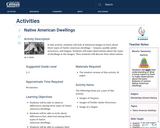
In this activity, students will look at historical images to learn about three types of Native American dwellings — teepees, pueblo adobe structures, and hogans. Students will make observations about the types of dwellings in the images. Then students will discuss their observations as a class.
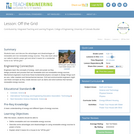
Students learn and discuss the advantages and disadvantages of renewable and non-renewable energy sources. They also learn about our nation's electric power grid and what it means for a residential home to be "off the grid."

The purpose of this task is to give students the opportunity to use mathematics in real-world applications. In this task, students are introduced to the ongoing problem of affordable housing faced by state and national community builders and city planners. Students are presented with two data tables illustrating cost of housing and wage increases over 20 years. Students discuss questions they can ask and answer using this data. They will calculate the cost increase of housing over time and compare it to wage increase, concluding with a discussion about the comparison. Includes slides to support the implementation of "Housing Our Community (Grades 3-5)" Math Performance Task with charts, images, etc.
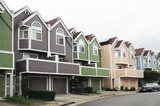
The purpose of this task is to give students the opportunity to use mathematics in real-world applications. In this task, students are introduced to the ongoing problem of affordable housing faced by community builders and city and state planners nationwide. Students are presented with a collection of representations of homes and people. Students discuss questions we can ask and answer using this data. They will use strategies to organize information and discover how many more people are there than homes. Includes slides to support the implementation of "Housing Our Community (K-2)" Math Performance Task with charts, images, etc.
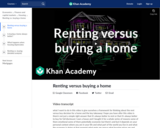
Renting vs. buying a house is a major consideration for many people. In this video we break down the considerations that go into calculating whether renting a house or buying a house is the best choice for someone. Created by Sal Khan.
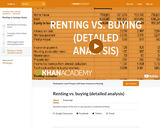
We explore a more detailed model, including a downloadable spreadsheet, that factors many of the considerations needed when deciding whether to rent a home vs. buying a home.

A short sale occurs when someone wants to sell a home, but owes more on the home than its value. We explore some of the major considerations that go into a short sale in this video. Created by Sal Khan.

Resources designed to introduce beginning level adult ELLs to laws in the US in regards to child welfare. Two weeks of activities including pictures, stories, handouts, and discussion questions around the topics of car and home safety for children.
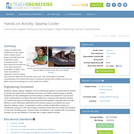
Using a household fan, cardboard box and paper towels, student teams design and build their own evaporative cooler prototype devices. They learn about the process that cools water during the evaporation of water. They make calculations to determine a room's cooling load, and thus determine the swamp cooler size. This activity adds to students' understanding of the behind-the-scenes mechanical devices that condition and move air within homes and buildings for human health and comfort.
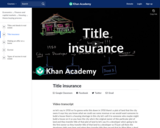
An introduction to title insurance. By Sal Khan.
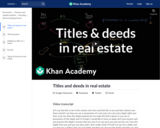
Just because someone lives in a house doesn't always mean that they have the right to sell that house. Learn about the role of possession, titles, and deeds in the home buying process in this video.
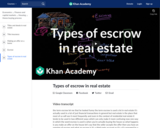
In real estate transactions there are typically several kinds of escrow accounts. Explore some of th different escrow real estate accounts in this video.

For many years, Cambridge, MA, as host to two major research universities, has been the scene of debates as to how best to meet the competing expectations of different stakeholders. Where there has been success, it has frequently been the result, at least in part, of inventive urban design proposals and the design and implementation of new institutional arrangements to accomplish those proposals. Where there has been failure it has often been explained by the inability - or unwillingness - of one stakeholder to accept and accommodate the expectations of another. The two most recent fall Urban Design Studios have examined these issues at a larger scale. In 2001 we looked at the possible patterns for growth and change in Cambridge, UK, as triggered by the plans of Cambridge University. And in 2002 we looked at these same issues along the length of the MIT ‘frontier’ in Cambridge, MA as they related to the development of MIT and the biotech research industry.
In the fall 2003 Urban Design Studio we propose to focus in on an area adjacent to Cambridgeport and the western end of the MIT campus, roughly centered on Fort Washington. Our goal is to discover the ways in which good urban form, an apt mix of activities, and effective institutional mechanisms might all be brought together in ways that respect shared expectations and reconcile competing expectations - perhaps in unexpected and adroit ways.

This studio discusses in great detail the design of urban environments, specifically in Providence, RI. It will propose strategies for change in large areas of cities, to be developed over time, involving different actors. Fitting forms into natural, man-made, historical, and cultural contexts; enabling desirable activity patterns; conceptualizing built form; providing infrastructure and service systems; guiding the sensory character of development: all are topics covered in the studio. The course integrates architecture and planning students in joint work and requires individual designs and planning guidelines as a final product.
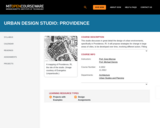
This studio discusses in great detail the design of urban environments, specifically in Providence, RI. It will propose strategies for change in large areas of cities, to be developed over time, involving different actors. Fitting forms into natural, man-made, historical, and cultural contexts; enabling desirable activity patterns; conceptualizing built form; providing infrastructure and service systems; guiding the sensory character of development: all are topics covered in the studio. The course integrates architecture and planning students in joint work and requires individual designs and planning guidelines as a final product.

This class presents an analysis of the development of housing models and their urban implications in Paris, London, and New York City from the seventeenth century to the present. The focus will be on three models: the French hotel, the London row house, and the New York City tenement and apartment building. Other topics covered will include twentieth-century housing reform movements and work by the London County Council, CIAM, and American public housing agencies.

The course explores the interactions between state and market as instigators of China’s urbanization, and its consequences of land, housing, transportation, energy, environment, migration, finance, urban inequality. Themes include the de-synchronization of China’s urbanization, potential differences between China’s past and future development, and differentiators between China’s urbanization and those of other countries. This discussion-based course asks students to participate in the conversation with the course instructor and guest lecturers by drawing upon their experiences and academic or professional backgrounds.